
A migrant worker calculating his owed salary at TWC2’s office
In the annual Employment Standards Report for 2024 recently released, the Tripartite Alliance for Dispute Management (TADM) once again claims a Soviet percentage of success in its handling of employment claims. TWC2 has long found this to be a rather mischievous and self-serving characterisation of its work.
On page 4 of the report, it says,
More than 80% of employment claims were resolved at TADM with more than 90% of claimants fully recovering their salaries and payments at TADM and the Employment Claims Tribunal (ECT).
(two words made red and bold by TWC2)
Whilst the above statement refers to all kinds of employment claims (of which salary claims make up 84%), the glorious claim is also repeated in relation to salary claims specifically. On page 8:
94% of the employees fully recovered their salaries at TADM and ECT, similar to 2023.
Since around 90% of cases were concluded at the TADM level, without having to go up to the ECT, much of the above claim must surely rest on what actually happened at TADM.
It takes a bit of expert knowledge about process to see what’s so woolly about the use of the term “fully recovered”. Firstly, TADM’s mandate is to mediate between parties; it is not to judge who is right or who is wrong. TADM does not decide what the correct claim quantum should be. Logically, therefore, it is impossible to know whether the agreed settlement represented full recovery or not, when “full” is never ascertained.
Just to be clear, at the ECT by contrast, the magistrate’s job is to make a determination as to how much is owed to whom. In such a setting, it is possible to know what “full” represents. However, the vast majority of cases did not go to the ECT, as the report itself pointed out.
In the interest of accuracy, the report contains a footnote (bottom of Page 8) explaining what it meant by “fully recovered”.
Based on the amount agreed between the parties involved in the dispute or the amount ordered by ECT.
In other words, TADM concedes that they are treating any compromise settlement reached at mediation to be “full recovery”. So, if a worker computes (even with evidence) that he was owed $12,500, but the employer pleads insufficient funds, and both parties agree to settle at $6,000 – quite often employees want to move on with their lives and will agree to a lesser amount – TADM treats the compromise figure of $6,000 as “full recovery”. It is plainly a mockery of the commonsense meaning of words.
TWC2 assists hundreds of workers with salary claims every year, and we typically begin by checking the evidence they have, such as In-principle Approval letters, time cards, payslips and bank statements. We have confidence that the claim amounts submitted by our clients are well-grounded. Yet, we know from our case files that a large majority of them agree to settle at lower amounts. “Fully recovered” is not a term that the workers themselves would recognise as the outcome they obtained.
The report would sound less self-serving if TADM didn’t use words so loosely.
The numbers
Language aside, the report has useful numbers. In 2024, TADM reported receiving 11,685 employment claims, split thus:
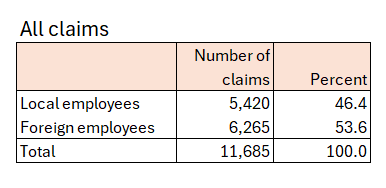
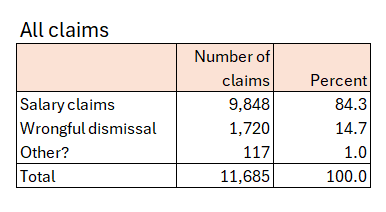
Frustratingly, the Report does not cross-tabulate its figures for salary or wrongful dismissal claims against local or foreign employees. Instead, it gives an incidence rate.
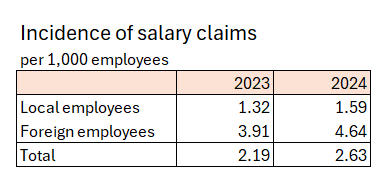
However, using the published numbers of foreign work pass holders, we can back-calculate the number of salary claims filed by foreign employees. Our calculations give us a figure of 5,916 such claims, representing 60.1% of all salary claims in 2024.
From MOM’s website:
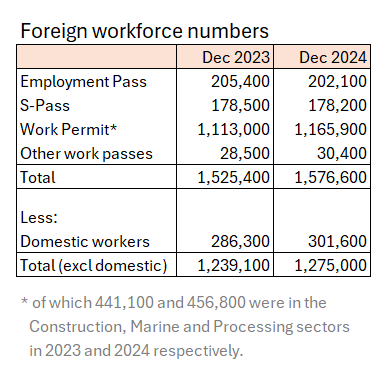
The report notes that of the salary claims filed by foreign employees, 53% came from the Construction sector, 10% from Manufacturing and 8% from the Food and Beverage Service sector.
As for wrongful dismissal claims, the incidence rates were:
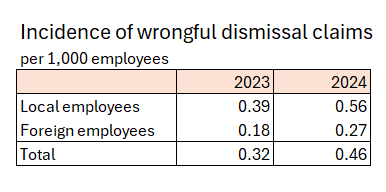
Back-calculating it, we derive a figure of 344 wrongful dismissal claims by foreign employees in 2024, representing 20% of all wrongful dismissal claims filed in that year.
The percentage of wrongful dismissal claims moved up from TADM to ECT and the percentage resolved are also described in the report, but because it does not segregate claims between local and foreign employees, it is not informative for the purposes of this article.
Also lacking is a statistical appendix, which is disappointing. One can only hope there will be improvements in detail, transparency and choice of words in years to come.
